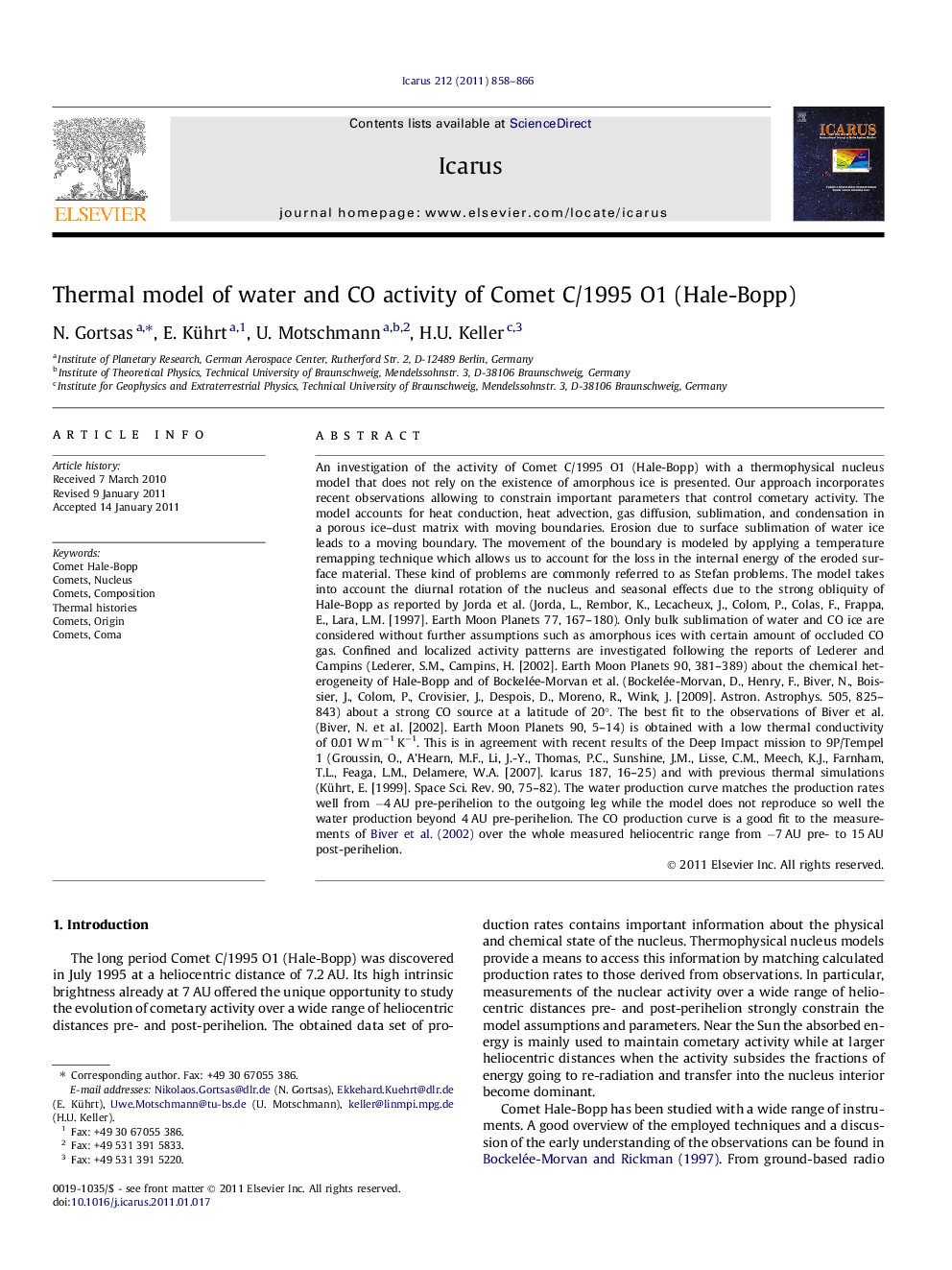| کد مقاله | کد نشریه | سال انتشار | مقاله انگلیسی | نسخه تمام متن |
|---|---|---|---|---|
| 1774607 | 1021169 | 2011 | 9 صفحه PDF | دانلود رایگان |

An investigation of the activity of Comet C/1995 O1 (Hale-Bopp) with a thermophysical nucleus model that does not rely on the existence of amorphous ice is presented. Our approach incorporates recent observations allowing to constrain important parameters that control cometary activity. The model accounts for heat conduction, heat advection, gas diffusion, sublimation, and condensation in a porous ice–dust matrix with moving boundaries. Erosion due to surface sublimation of water ice leads to a moving boundary. The movement of the boundary is modeled by applying a temperature remapping technique which allows us to account for the loss in the internal energy of the eroded surface material. These kind of problems are commonly referred to as Stefan problems. The model takes into account the diurnal rotation of the nucleus and seasonal effects due to the strong obliquity of Hale-Bopp as reported by Jorda et al. (Jorda, L., Rembor, K., Lecacheux, J., Colom, P., Colas, F., Frappa, E., Lara, L.M. [1997]. Earth Moon Planets 77, 167–180). Only bulk sublimation of water and CO ice are considered without further assumptions such as amorphous ices with certain amount of occluded CO gas. Confined and localized activity patterns are investigated following the reports of Lederer and Campins (Lederer, S.M., Campins, H. [2002]. Earth Moon Planets 90, 381–389) about the chemical heterogeneity of Hale-Bopp and of Bockelée-Morvan et al. (Bockelée-Morvan, D., Henry, F., Biver, N., Boissier, J., Colom, P., Crovisier, J., Despois, D., Moreno, R., Wink, J. [2009]. Astron. Astrophys. 505, 825–843) about a strong CO source at a latitude of 20°. The best fit to the observations of Biver et al. (Biver, N. et al. [2002]. Earth Moon Planets 90, 5–14) is obtained with a low thermal conductivity of 0.01 W m−1 K−1. This is in agreement with recent results of the Deep Impact mission to 9P/Tempel 1 (Groussin, O., A’Hearn, M.F., Li, J.-Y., Thomas, P.C., Sunshine, J.M., Lisse, C.M., Meech, K.J., Farnham, T.L., Feaga, L.M., Delamere, W.A. [2007]. Icarus 187, 16–25) and with previous thermal simulations (Kührt, E. [1999]. Space Sci. Rev. 90, 75–82). The water production curve matches the production rates well from −4 AU pre-perihelion to the outgoing leg while the model does not reproduce so well the water production beyond 4 AU pre-perihelion. The CO production curve is a good fit to the measurements of Biver et al. (2002) over the whole measured heliocentric range from −7 AU pre- to 15 AU post-perihelion.
Research highlights
► The CO and water activity of Comet C/1995 O1 (Hale-Bopp) is simulated.
► Erosion due to surface sublimation of water ice is treated as a Stefan Problem.
► The CO production curve is a good fit to the measurements over the whole range.
► The best fit of the data is obtained with a thermal conductivity of 0.01 W/(mK).
Journal: Icarus - Volume 212, Issue 2, April 2011, Pages 858–866